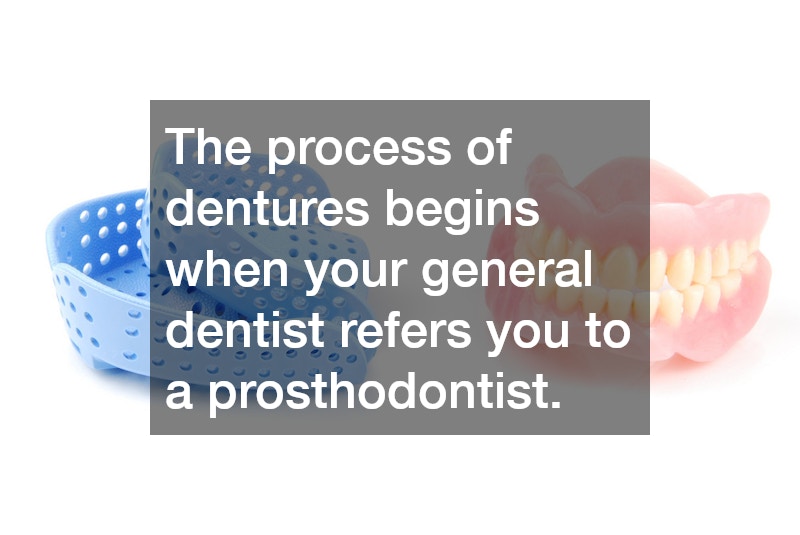
If you are having difficulty eating your food due to multiple tooth loss, you may want to talk with your dentist about getting dentures. Benefits of dentures include improved ability to eat, better speech, and more cohesive facial symmetry. Once your dentist makes the decision that you would benefit from dentures, they will refer you to a specialty dentist called a prosthodontist to carry out the denture care services.

Prosthodontists are dental specialists who provide examinations, measurements, and complete & partial dentures. Complete dentures cover the upper or lower jaw, (or both) while partial dentures may include metallic clasps so they can attach to nearby permanent teeth. These clasps will provide additional stability for your dentures.
The process of dentures begins when your general dentist refers you to a prosthodontist. The prosthodontist will then measure your mouth and make an impression of your jaws. These impressions will be sent to a dental lab, and a set of dentures will be made. Your prosthodontist will help you as you fit your dentures for the first time, and to be certain they fit comfortably for maximum biting, chewing, and speech functions.


The dental implant/ denture industry is booming in Canada, partly because of the fact that there are at least 12 million Canadians with at least one untreated dental need. As of 2012, the dental implant industry was worth an estimated $80 million. There are 4 colleges of Denturism in Canada, with about 2,000 Denturists (people who measure and fit dentures) qualified today.
If you think you might need to get dentures, you should know your options. Here’s a quick guide on the types of dentures:
Standard dentures- with these dentures, the back hits just behind the hard part of the roof of the mouth. Large surface required for stability as suction is what keeps it in the roof of the mouth, so they can be cut back for people with a shallow gag reflex, but it is not recommended.
Immediate/ temporary dentures- often made before any teeth are extracted, so the patient has something to wear home, post-operation. The temporary denture often acts as a band-aid over the tooth extraction site, helping with pain and helping the patient feel confident over the next couple of weeks as they heal.
Transitional/ partial dentures- these are dentures with holes for natural teeth that are still in the mouth. Generally recommended for people whose remaining teeth will eventually come out. These dentures also may eventually be filled in and become full dentures if the healthy teeth are lost.
Overdentures- overdentures are a device that goes over existing teeth, or what is left of them. These were commonplace before modern dentistry made oral surgery possible. Today, they are often used over teeth that have had root canals but do not rise above the gumline. The advantage in leaving these teeth in is that the bone recedes once the roots are removed, making it harder for dentures to stay in.
Implant retained dentures- these are dentures through which a dental implant is threaded, making the denture more stable. Of the types of dentures, this one is recommended for those who cannot tolerate a full upper plate, as the implant stabilizes without one.
Read more about this topic at this link. Continue reading here.
